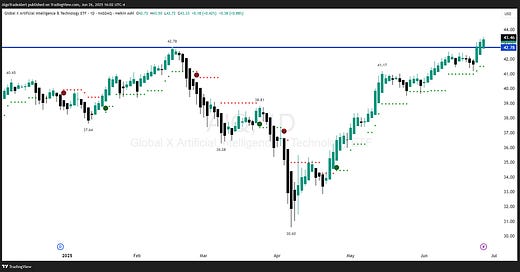Stock Market Update Thursday June 26, 2025 Market Recap – June 26: Bulls in Control Amid Easing Expectations Risk assets extended gains as equity markets powered higher, with the S&P 500 advancing 0.8%, approaching its February peak and reaffirming bullish momentum. Market sentiment was buoyed by a continued shift in interest rate expectations, as the two-year Treasury yield fell an additional four basis points to 3.70%, marking a cumulative 24 bps decline over five sessions—a clear signal that markets are anticipating a near-term Fed pivot.
In the commodities complex, WTI crude oil remained range-bound at $65 and change per barrel, reflecting a balance of weak demand signals and constrained supply narratives. Gold traded flat around $3,330 per ounce, holding firm amid stable real yields. Bitcoin likewise traded sideways near $108,000, consolidating recent gains in the digital asset space. Meanwhile, volatility stayed suppressed, with the VIX comfortably below 17, highlighting persistent risk-on sentiment and low hedging activity.
Quantitative Tightening Update: Fed Balance Sheet Trends
The Federal Reserve’s quantitative tightening (QT) program continues at a deliberate pace, with a modest $3.3 billion week-over-week decline in Reserve Bank credit. The Fed’s portfolio of interest-bearing assets now stands at $6.628 trillion, reflecting a minimal $9 billion reduction since the final Thursday of May. This leaves the balance sheet 25.7% below its all-time high set in March 2022, underscoring the gradual unwinding of pandemic-era monetary expansion. While the pace of QT has slowed, the cumulative runoff remains substantial, reflecting the Fed’s continued commitment to policy normalization even as market participants increasingly price in monetary easing later this year.
Fed Chair Powell Signals Dovish Tilt Amid Tariff Concerns
Federal Reserve Chair Jerome Powell resumed his congressional testimony yesterday, during which he was asked why the central bank isn’t responding more forcefully to tariff-induced inflationary pressures. Powell clarified that the Fed’s base-case scenario views the recent price increases as transitory and largely exogenous, stemming from a one-off adjustment rather than a sustained inflationary trend. However, he acknowledged the uncertainty surrounding the duration and pass-through effects of these tariffs. Importantly, Powell noted that a majority of Federal Open Market Committee (FOMC) participants expect rate cuts before year-end—a clearly dovish signal that reinforces market expectations for monetary easing.
Keep reading with a 7-day free trial
Subscribe to Daily Stock Market Update to keep reading this post and get 7 days of free access to the full post archives.




